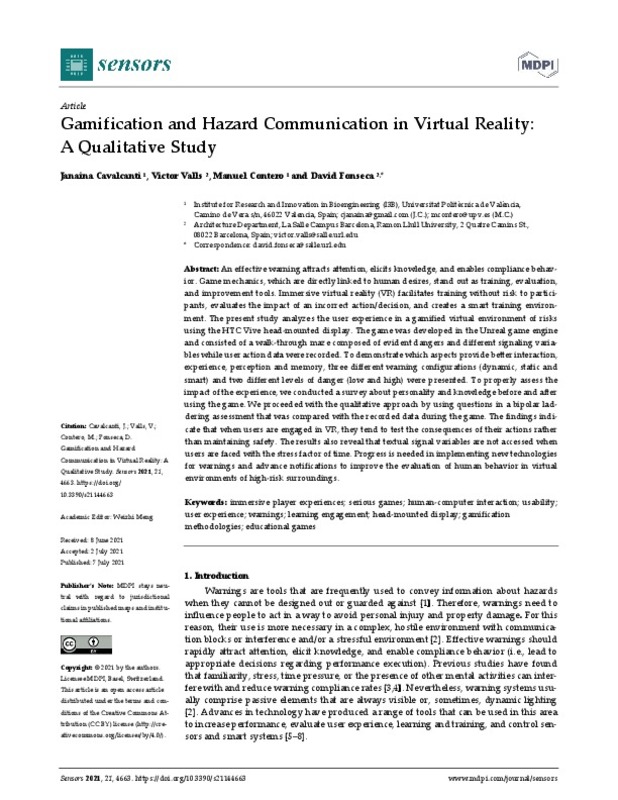JavaScript is disabled for your browser. Some features of this site may not work without it.
Buscar en RiuNet
Listar
Mi cuenta
Estadísticas
Ayuda RiuNet
Admin. UPV
Gamification and hazard communication in virtual reality: A qualitative study
Mostrar el registro sencillo del ítem
Ficheros en el ítem
| dc.contributor.author | Cavalcanti, Janaina
|
es_ES |
| dc.contributor.author | Valls, Victor
|
es_ES |
| dc.contributor.author | Contero, Manuel
|
es_ES |
| dc.contributor.author | Fonseca, David
|
es_ES |
| dc.date.accessioned | 2022-01-30T19:06:29Z | |
| dc.date.available | 2022-01-30T19:06:29Z | |
| dc.date.issued | 2021-07 | es_ES |
| dc.identifier.uri | http://hdl.handle.net/10251/180367 | |
| dc.description.abstract | [EN] An effective warning attracts attention, elicits knowledge, and enables compliance behavior. Game mechanics, which are directly linked to human desires, stand out as training, evaluation, and improvement tools. Immersive virtual reality (VR) facilitates training without risk to participants, evaluates the impact of an incorrect action/decision, and creates a smart training environment. The present study analyzes the user experience in a gamified virtual environment of risks using the HTC Vive head-mounted display. The game was developed in the Unreal game engine and consisted of a walk-through maze composed of evident dangers and different signaling variables while user action data were recorded. To demonstrate which aspects provide better interaction, experience, perception and memory, three different warning configurations (dynamic, static and smart) and two different levels of danger (low and high) were presented. To properly assess the impact of the experience, we conducted a survey about personality and knowledge before and after using the game. We proceeded with the qualitative approach by using questions in a bipolar laddering assessment that was compared with the recorded data during the game. The findings indicate that when users are engaged in VR, they tend to test the consequences of their actions rather than maintaining safety. The results also reveal that textual signal variables are not accessed when users are faced with the stress factor of time. Progress is needed in implementing new technologies for warnings and advance notifications to improve the evaluation of human behavior in virtual environments of high-risk surroundings. | es_ES |
| dc.description.sponsorship | This research was funded by La Salle Ramon Llull University and La Salle Catalunya through the project EduEnginy. This research paper was also supported by the GRETEL research group and the Secretaria d'Universitats i Recerca del Departament d'Empresa i Coneixement de la Generalitat de Catalunya (grant 2017 SGR 934), and the National Program of Research, Development and Innovation aimed at the Society Challenges with the reference BIA2016-77464-C2-2-R of the National Plan for Scientific Research, Development and Technological Innovation 2013-2016, Government of Spain, titled "Diseno Gamificado de visualizacion 3D con sistemas de realidad virtual para el estudio de la mejora de competencias motivacionales, sociales y espaciales del usuario (EduGAME4CITY)". (AEI/FEDER, UE). | es_ES |
| dc.language | Inglés | es_ES |
| dc.publisher | MDPI AG | es_ES |
| dc.relation.ispartof | Sensors | es_ES |
| dc.rights | Reconocimiento (by) | es_ES |
| dc.subject | Immersive player experiences | es_ES |
| dc.subject | Serious games | es_ES |
| dc.subject | Human-computer interaction | es_ES |
| dc.subject | Usability | es_ES |
| dc.subject | User experience | es_ES |
| dc.subject | Warnings | es_ES |
| dc.subject | Learning engagement | es_ES |
| dc.subject | Head-mounted display | es_ES |
| dc.subject | Gamification methodologies | es_ES |
| dc.subject | Educational games | es_ES |
| dc.subject.classification | EXPRESION GRAFICA EN LA INGENIERIA | es_ES |
| dc.title | Gamification and hazard communication in virtual reality: A qualitative study | es_ES |
| dc.type | Artículo | es_ES |
| dc.identifier.doi | 10.3390/s21144663 | es_ES |
| dc.relation.projectID | info:eu-repo/grantAgreement/MINECO//BIA2016-77464-C2-2-R/ | es_ES |
| dc.relation.projectID | info:eu-repo/grantAgreement/GC//2017 SGR 934/ | es_ES |
| dc.rights.accessRights | Abierto | es_ES |
| dc.contributor.affiliation | Universitat Politècnica de València. Departamento de Ingeniería Gráfica - Departament d'Enginyeria Gràfica | es_ES |
| dc.description.bibliographicCitation | Cavalcanti, J.; Valls, V.; Contero, M.; Fonseca, D. (2021). Gamification and hazard communication in virtual reality: A qualitative study. Sensors. 21(14):1-18. https://doi.org/10.3390/s21144663 | es_ES |
| dc.description.accrualMethod | S | es_ES |
| dc.relation.publisherversion | https://doi.org/10.3390/s21144663 | es_ES |
| dc.description.upvformatpinicio | 1 | es_ES |
| dc.description.upvformatpfin | 18 | es_ES |
| dc.type.version | info:eu-repo/semantics/publishedVersion | es_ES |
| dc.description.volume | 21 | es_ES |
| dc.description.issue | 14 | es_ES |
| dc.identifier.eissn | 1424-8220 | es_ES |
| dc.identifier.pmid | 34300401 | es_ES |
| dc.identifier.pmcid | PMC8309665 | es_ES |
| dc.relation.pasarela | S\453758 | es_ES |
| dc.contributor.funder | Generalitat de Catalunya | es_ES |
| dc.contributor.funder | European Regional Development Fund | es_ES |
| dc.contributor.funder | Ministerio de Economía y Competitividad | es_ES |








